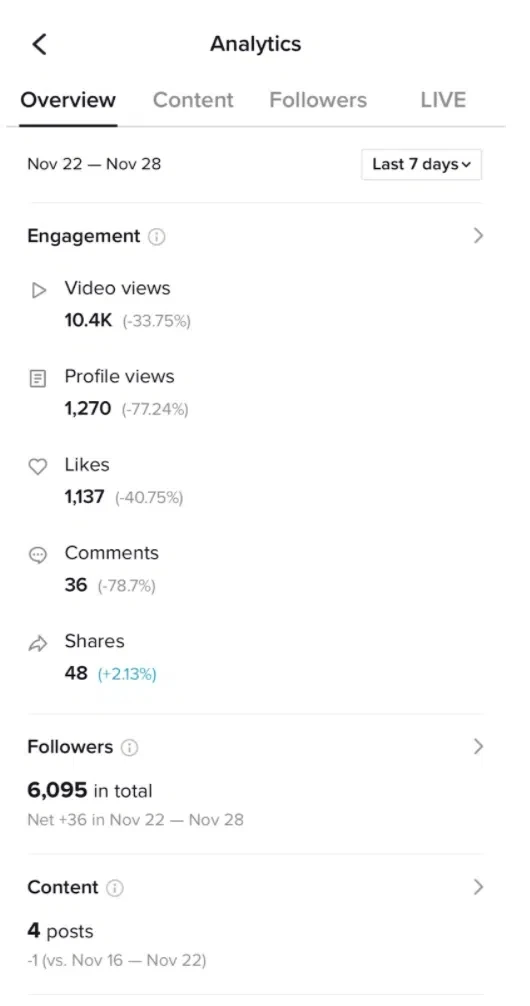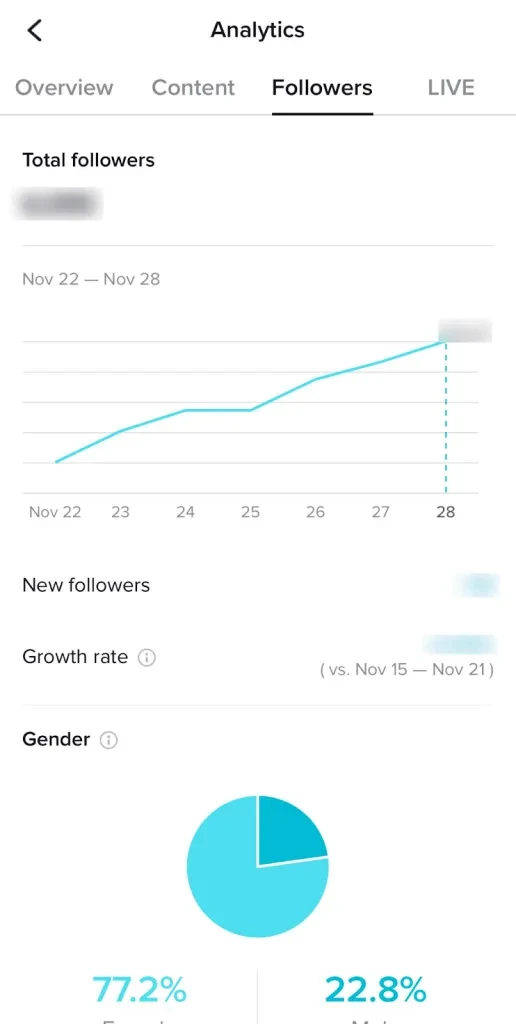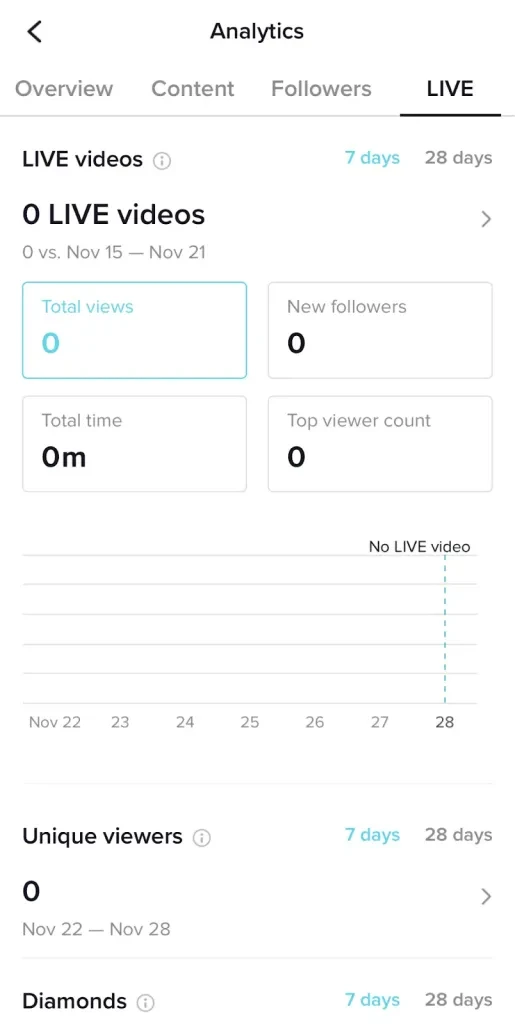TikTok metrics are your secret weapon in the quest for marketing success on the platform. They empower you to make data-driven decisions, fine-tune your strategy, and drive remarkable results. So, let’s dive deeper into this world of metrics and unlock the potential of TikTok for your business.
If you’re still at the stage of building a TikTok marketing strategy that’s okay, you just might want to check out this blog on creating a TikTok marketing strategy first, and then come back here once you’re ready to delve deeper into understanding TikTok metrics.
Table of Contents
Who can view TikTok analytics?
How to check your TikTok analytics?
Why are TikTok analytics important?
What do TikTok analytics metrics mean?
Other TikTok metrics to consider
What key performance indicators (KPIs) should you focus on?
How often should you check your TikTok metrics?
Conclusion
Who can view TikTok analytics?
Anyone with a TikTok business account can view analytics that help with their marketing strategy and monitor success.
If you don’t already have a TikTok business account, switch today. Here’s how:
- Log in to your existing TikTok account and go to your profile page.
- Open the settings tab.
- Click on account.
- Then click on Switch to Business Account.
If you don’t have a TikTok account yet at all, start with the basics of creating a TikTok account and how to use it to boost your business.
How to check your TikTok analytics?
Once you have a business account, it’s easy to check your TikTok analytics. Here is where to find them:
On a phone, in settings and privacy under account, choose the creator tools tab and select analytics.
On a desktop, hover over your profile picture and click analytics.
You can download your analytics data on the desktop dashboard but not on mobile. Also, if you have signed up for the TikTok business suite for TikTok Ads, you will find your analytics in the business suite tab on both mobile and desktop.
Why are TikTok analytics important?
TikTok metrics play a pivotal role in social media marketing, offering a treasure trove of insights that can make or break your marketing efforts on the platform. Here is more information on why these metrics are indispensable for businesses:
- Performance evaluation: They give you a clear understanding of how your content is performing. You can see which videos are shining and which ones might need a little extra sparkle.
- Audience insights: Want to know who’s vibing with your content? TikTok metrics offer a backstage pass to your audience’s preferences and demographics. With this knowledge, you can tailor your content to resonate with your target audience.
- ROI assessment: TikTok metrics allow you to track the dollars and cents, helping you understand the real impact of your marketing campaigns. Are your efforts translating into actual results? The metrics hold the answer.
- Content optimization: They reveal what’s working and what’s not and can guide you to content your audience can’t resist.
- Budget allocation: Every dollar spent on marketing counts. TikTok metrics help you maximize your budget by identifying high-performing videos and campaigns. Then, you can funnel your resources where they’ll yield the best returns.
- Feedback and engagement: Metrics like comments and shares are like direct messages from your audience. They offer valuable feedback and insights you can use to improve your content.
The data from TikTok metrics isn’t just for the here and now. It’s your blueprint for the future. With it, you can set smart goals and keep track of your progress as you work toward them. Additionally, if you’re running TikTok ads, metrics become your compass. They guide you in fine-tuning your ad campaigns. A/B testing different ad creatives, budgets, and targeting options can help you maximize your ROI.
What do TikTok analytics metrics mean?
TikTok divides its analytics into four categories: overview, content, followers and LIVE. Let’s take a look at what each of these means.
Overview
In the overview section of the analytics, it shows you a quick overview of things you might be interested in seeing. It automatically offers the basic analytics for the past seven days, but it can show you the last month, two months, or a custom date range.
Here, it will show you video views, profile views, likes, comments, and shares along with your total followers and how many followers you have increased or decreased over the period chosen. As you can see in the screenshot below, there is also a percentage next to each engagement metric; this shows how much this metric has increased or decreased from the previous week.

Content
In the content section, it shows which videos were the most popular during the date range selected. It is super helpful to see how your latest posts are doing.
Followers
As the name suggests, the follower tab gives you more in-depth information about your followers. It provides your total follower count along with the number of new followers you’ve gained during the selected period with a helpful graph to see the growth.
There is also a breakdown of who your followers are by gender, their location, and even the times they are most active. This can help you better know your target audience and the best times to post to reach them.

LIVE
TikTok Live is a feature that allows users to broadcast live video content to their followers and engage with their audience in real time. So, the live section of the analytics shows you information about the lives you have hosted, including how much time you’ve spent live, the number of new followers and how many diamonds you’ve earned, which is a part of LIVE gifting.

Other TikTok metrics to consider

If you’ve been around social media for a while, you’ve probably heard the term engagement. Engagement is a metric that people often use to determine how well their content is performing on social media, but how do you calculate it?
To calculate engagement on a particular video, you add up the total likes, comments and shares on the video, divide that by the total number of views and multiply that by 100 to get a percentage.
What key performance indicators (KPIs) should you focus on?

You may want to focus on different metrics depending on what your specific goals on TikTok are. However, here are a few metrics to start monitoring to get started:
Video views
Video views is a great place to start because it’s easy to understand, and a great perk with TikTok is that you don’t have to have a high follower count to get a decent number of views.
Try out different types of content on your channel and use views to see what is resonating most with people.
Another great thing is that you can use video views to compare to competitors since they’re public. Check out the highest-viewed videos of your competitors to see what’s working best for them.
Profile views
Because businesses are looking to convert viewers and social media followers into customers, a great metric to look at is profile views. Look at how many people have viewed your profile and compare it to the total video views. This will give you insight into whether or not your content is compelling enough to get people to click on your profile after viewing content.
Average watch time
You can see the average watch time for videos, which provides valuable insight as to whether or not your videos are maintaining your viewer’s attention. So, of course, you want to see longer watch times and, ideally, people watching the entire video.
If you are seeking shorter watch times, think about ways you can draw your audience in within the first few seconds of the video and how to keep them engaged. You should experiment with video style, scripts and lengths to see what works best.

How often should you check your TikTok metrics?
There isn’t a strict, universally defined frequency for checking TikTok metrics, as it can depend on various factors, including your specific goals, the volume of content you create, and the resources available. However, it’s recommended to check your TikTok metrics regularly to ensure that you’re making data-driven decisions and staying on top of your performance.
Here’s a general guideline on how often you might consider checking your TikTok metrics:
- Daily or every other day: For active content creators and businesses with a high posting frequency, checking metrics daily or every other day can be beneficial. This allows you to stay updated on the performance of your recent posts, respond to comments, and identify trends quickly.
- Weekly: For most businesses and content creators, a weekly metrics check is a good practice. This provides a comprehensive view of your performance and allows you to spot trends and patterns over time.
- Monthly: If you have a more relaxed posting schedule or your content has a longer shelf life, monthly checks may suffice. This is especially applicable to businesses focusing on long-term strategies rather than rapid changes.
- Campaign-based: If you’re running specific marketing campaigns or promotions, you should monitor metrics more frequently during the campaign’s duration and immediately after. This might involve daily or real-time tracking for the campaign’s active phase.
Remember that the key is not just to monitor metrics but to act on the insights gained. If you notice certain content types or posting times consistently perform well, adjust your strategy accordingly.
Conclusion
Tracking and analyzing your TikTok metrics is a critical part of your social media marketing strategy. Understanding these metrics helps you to improve your content, grow your audience, and increase your sales base.
If you want to learn more about running TikTok Ads, then check out our guide here.



